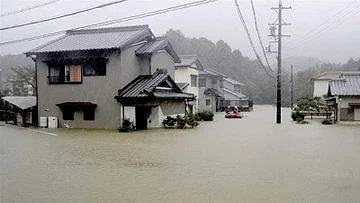Japan rescuers seek survivors after Typhoon Hagibis kills 43
Even as rescuers, including troops, combed through debris, the country’s weather agency forecast rain in central and eastern Japan and warned it could cause further flooding and new landslides

Tens of thousands of rescue workers in Japan battled on Monday to find survivors of a powerful typhoon that killed at least 43 people, as fresh rain threatened to hamper efforts.
Typhoon Hagibis crashed into the country on Saturday night, unleashing high winds and torrential rain across 36 of the country's 47 prefectures, and triggering landslides and catastrophic flooding.
"Even now, many people are still unaccounted for in the disaster-hit area," Prime Minister Shinzo Abe told an emergency disaster meeting on Monday.
"Units are trying their best to search for and rescue them, working day and night," Abe said.
But even as rescuers, including troops, combed through debris, the country's weather agency forecast rain in central and eastern Japan and warned it could cause further flooding and new landslides.
"I would like to ask people to stay fully vigilant and continue watching for landslides and river flooding," Chief Cabinet Secretary Yoshihide Suga told a news conference.
In Nagano, one of the worst-hit regions, the rain was already falling and was expected to intensify.
"We are concerned about the impact of the latest rain on rescue and recovery efforts," local official Hiroki Yamaguchi told AFP.
"We will continue operations while watching out for secondary disasters due to the current rain." By late Monday afternoon, national broadcaster NHK said the toll had risen to 43 dead, with 16 others missing and over 200 people injured. The government gave lower figures but was continuing to update its information.
The dead included a municipal worker whose car was overcome by floodwaters and at least seven crew from a cargo ship that sank in Tokyo Bay on Saturday night, a coast guard spokesman said.
Four others, from China, Myanmar and Vietnam, were rescued when the boat sank and the coast guard was still searching for the last crew member.
While Hagibis, one of the most powerful storms to hit the Tokyo area in decades, packed wind gusts of up to 216 kilometres (134 miles) per hour, it was the heavy rains that caused the most damage.
A total of 142 rivers flooded, mainly in eastern and northern Japan, with river banks collapsing in two dozen places, local media said.
In central Nagano, a levee breach sent water from the Chikuma river gushing into residential neighbourhoods, flooding homes up to the second floor.
As the water slowly receded Monday, television footage showed patients being transferred by ambulance from a Nagano hospital where some 200 people had been cut off by flooding.
Elsewhere, rescuers used helicopters to winch survivors from roofs and balconies, or steered boats through muddy waters to reach those trapped.
By Monday afternoon, some 75,900 households remained without power, with 120,000 experiencing water outages.
The disaster left tens of thousands of people in shelters, with many unsure when they would be able to return home.
"Everything from my house was washed away before my eyes, I wasn't sure if it was a dream or real," a woman in Nagano told NHK.
"I feel lucky I'm still alive."
The storm brought travel chaos over the holiday weekend, grounding flights and halting commuter and bullet train services.
By Monday, most subway trains had resumed service, along with many bullet train lines, and flights had also restarted.
The storm also brought havoc to the sporting world, forcing the delay of Japanese Grand Prix qualifiers and the cancellation of three Rugby World Cup matches.
But a crucial decider pitting Japan against Scotland went ahead, with the hosts dedicating their stunning 28-21 win to the victims of the disaster.
"To everyone that's suffering from the typhoon, this game was for you guys," said Japan captain Michael Leitch.
Follow us on: Facebook, Twitter, Google News, Instagram
Join our official telegram channel (@nationalherald) and stay updated with the latest headlines